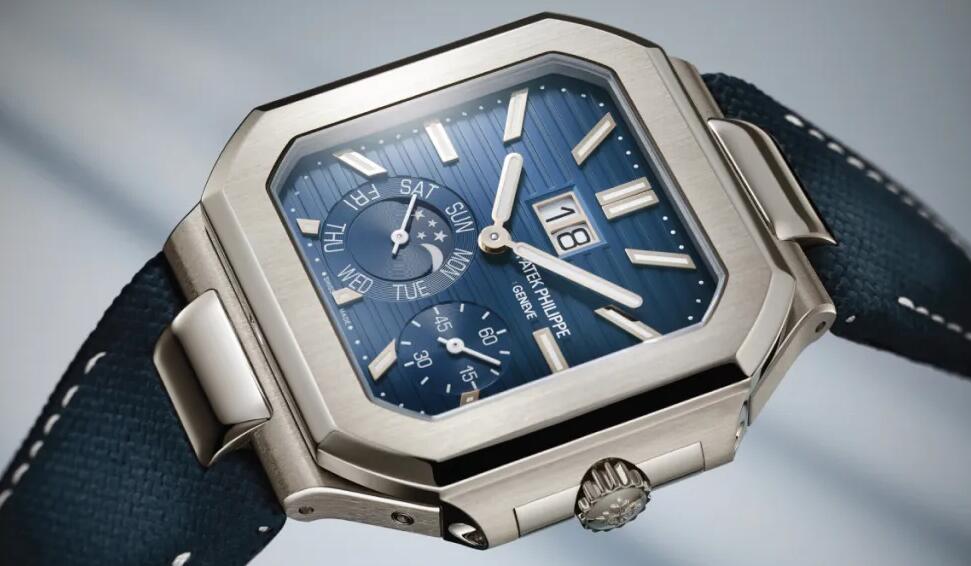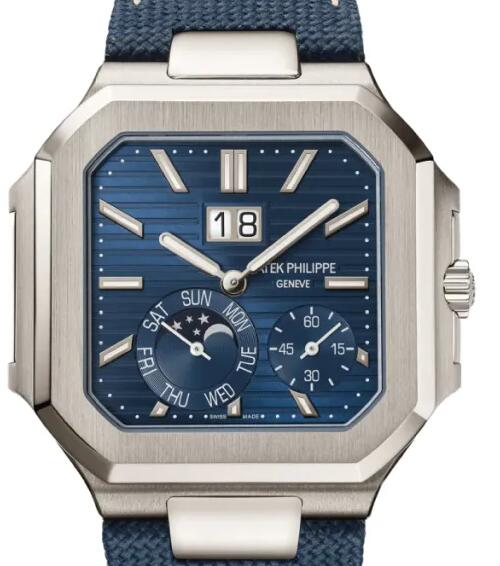I recently wrote that the greatest watch of the 21st century is Patek Philippe’s Calatrava reference 5226G, a watch that stirred up some controversy upon its release in 2022. Just last month Patek released a far more controversial Swiss made replica watches: the Cubitus reference 5822P. Though Patek released two references (and three colorways) in the Cubitus line, the brand has led with the platinum 5822P calendar watch in its initial advertising campaign, thus empowering this reference to fuel initial reactions.
It’s hard to recall such shock at the release of a new watch line than the reaction garnered by the Cubitus. The Audemars Piguet Code 11.59 saw a similar reaction upon release in 2019. I personally found the Code 11.59 numbing, but the general reaction seemed to be repulsion. Why such reactions to new high quality fake watches from these storied members of the so-called Horological Holy Trinity? Both Audemars Piguet and Patek Philippe have had to navigate the insurmountable legacy of the Royal Oak and Nautilus respectively. Releasing alternatives to these Gerald Genta-designed horological icons of the 1970s—and smash hits of the last decade—was always going to inspire strong reactions.
The luxury UK replica Patek Philippe Cubitus 5822P watches, however, did not appear to inspire intellectual disapproval or anything like careful consideration. It instead ignited instantaneous, gut-level rejection. Friends, family, and colleagues alike gasped. Ben Clymer of Hodinkee noted at the top of his write-up that “this is not a love letter,” and then spent many paragraphs padding what is ultimately a pretty negative take. I have yet to read a single sentence overtly praising the Cubitus, yet I’ve read hundreds of sentences trying to make sense of the watch.
So controversial is the Cubitus 5822P that I’ve now read everything from psychological theories about human reactions to novelty (we’ll get used to it) to historical contextualization (it’s the Nautilus of now) to quasi-Jungian accounts of the zeitgeist (no easy explanation, sorry). All were uncharacteristically ponderous—even philosophical—attempts by journalists to understand the top AAA copy watches. The more I read, the more I remained puzzled…and curious.
Then I tried on the 5822P at a Patek Philippe boutique in Hong Kong. Many have said the Cubitus is better in person, and while I somewhat agree (because the quality, as with all Patek Philippe replica watches for men, is astounding), I still walked away feeling as I did upon seeing the photographs: shocked that this was the new Patek Philippe. Yes, the Cubitus is thin and mechanically impressive and impeccably finished, but none of that put a dent in how jarring it was for me to behold the Cubitus 5822P. What I couldn’t get past, to be frank, was that there seemed to be something wrong with the reference 5822P. As I’ve mentioned, the execution is impeccable, so it had to be something in the design.
Coincidentally, just as the Cubitus was released, A. Lange & Söhne was sending out embargoed images of the new Lange 1. We recently ran a few stories on the Lange 1, including a new complete history, an anniversary story in the November issue of Robb Report, and a special edition of our weekly digital column Shopping Time. As a result, for a week or so I was thinking quite deeply about this German watch that is widely regarded as a design masterpiece. And I noted the similarities to the Cubitus: general asymmetry, sub-dials of different sizes, and a big date.
Famously, the Lange 1 uses the golden ratio and the related rule of thirds to arrange its dial. Without going too far into it, these are something like rules that guide designers toward what are thought to be universally appealing layouts. As you can see in the image below, the Lange 1 deconstructs its dial into asymmetry, but the elements are arranged to form a very pleasing equilateral triangle. The Lange 1 is broadly regarded as a modern classic of Swiss movements replica watches design—a grand success.
Follow the design of the Cubitus dial, however, and you end up with an off-kilter triangle that carves up the rectilinear dial into areas of apparently random size and shape. The sub-dials leave the lower five hour-markers at varying lengths and shapes. The large date aperture seems to steal the weight from the 12 o’clock marker, which typically anchors a watch dial along with a logo beneath it. Perhaps most crucially, the central arbor of the 5822P lacks a meaningful relationship to the two sub-dials.
Is it possible that there is something essentially “off” about the design of the Cubitus 5822P. If so, is that why the release was so jarring?
To check my interpretation of the Cubitus, I spoke with well-known watch designer Matt Smith-Johnson, who has long offered up revised designs of pre-existing cheap super clone watches. Regarding the 5822P, Johnson told Robb Report that, “The layout of the elements on the dial is not pleasing. It does not feel balanced.” He goes on to note that the day-wheel uses a Eurostile type that has been stretched vertically, a faux pas of graphic design.
Drawing his eye to the lower half of the dial, Johnson echoed my reaction: “Look how pinched off those indicies are between four and seven o’clock. It looks like [the movement] has been shoehorned.”
It’s not easy to get all the elements on a dial exactly where one would want them. The movement of the Lange 1 was designed from the ground-up to place the dial elements precisely in accordance with the golden ratio. In the fake Patek Philippe Cubitus watches we find the caliber 240 PS CI J LU, which has been derived from the familiar family of 240 calibers, specifically the 240 PS IRM C LU used in the Nautilus 5712. Clearly Patek has done a great deal of modification to the Cubitus movement, but the crucial placement of the sub-dials does not appear to have been modified.
Comparing the tranquil Lange 1 to the best replica Patek Philippe Cubitus 5822P watches raises persistent—and probably unanswerable—questions about aesthetics: Are there proportions and ratios that reliably deliver beauty almost every time for almost everyone? Or can compositions be tossed about willy-nilly with varying degrees of appeal (perhaps based on culturally informed preferences)? In other words: Is beauty universal or relative?
My answer is a rather typical hedge: I subscribe to the idea of universally pleasing compositions (I use the rule of thirds all day long to decent effect), but I also believe that we can grow accustomed to—and even come to prefer—designs that betray aesthetic norms and designers’ rules and are, thus, initially jarring.
When I was 12, I came into possession of a cassette tape from the Clash. It sounded like a mess, and it hurt my ears. In an effort to be a cool kid, I persisted in listening. After about a week I grew used to The Clash. After another week I liked the music. After another week The Clash was among my favorite bands, and I was on the path to punk rock.
More than a couple journalists have suggested that perhaps some of us just need to persist against our initial reactions to the Cubitus 5822P. We just need time to get used to it. But I’m not 12-years-old, and my personal tastes have grown relatively inflexible over time. Perhaps, then, the Cubitus 5822P is better suited to younger buyers whose tastes are still forming. Or perhaps there really is just something essentially wrong with the design, an insurmountable lack of visual harmony, asymmetry without an underlying logic. Wherever you land on that point may come down to your aesthetic philosophy, and this copy watches UK site might drive us toward yet another reckoning between essentialists and relativists. For that I can say that the Cubitus 5822P is—to use a phrase I often hear bandied about in the art world—”a very challenging piece.”





